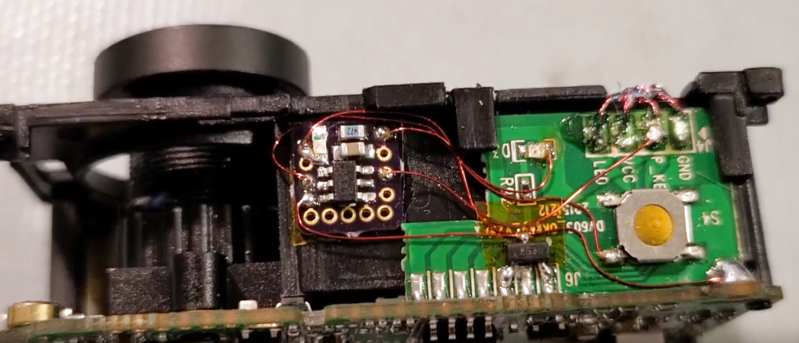Repurposing commodity electronics is one of the true forms of hacking, and it’s always the simple little hacks that lead to big ones. [Everett] wanted to use a $20 GoPro clone as a dash cam, so he wired a microcontroller into it to automate some actions and make it practical.
The camera turns on automatically when connected to external power like a car charger, but starting and stopping a recording and power down all had to be done manually. [Everett] wanted to automate these functions, so he opened up the camera and started probing with an oscilloscope. He found the power button, record button, 3.3 V and external 5 V traces conveniently next to each other in the top of the camera.
To automate the required functions, he wired in a PIC10 on a small breakout board, powered by the 3.3 V line. It detects if 5 V is connected to the charging port on start-up via an N-channel FET, then automatically starts a recording. When the 5 V power is switched off with the car, it waits 10 seconds before stopping the recording and switching off the camera. If no external 5 V is not detected on start-up the microcontroller does nothing, which allows the camera to be used as a normal handheld. [Everett] mounted the camera to his rearview mirror with a magnetic bracket made using a combination of a 3D printer and 3D pen.
This is a simple and practical little hack, and the firmware is available on Github. Cheap dashcams are available for similar prices, but you won’t get any hacking satisfaction that way.
The very nature of actions cameras inspire hacking. You can simply add an external battery with the help of a 3D printer, or go all out and build a gimballed helmet cam from scratch
















This cheap cameras has the “auto-registrator” mode. Look for menu items. Other one, and this is really problem,- they no compress files (problem with codec’s licenses?) as result, a rare file is not corrupted on a SD.
You can do all this with capacitors, resistors, and a few relays or transistor. You don’t even need a 555. When one capacitor charges on power on, a record button is pressed. When a second capacitor is charged, the button is released. Do the opposite for off state.
“You don’t even need a 555. ”
Boo! Hiss! Burn the heretic at the stake!
B^)
-1, Inelegant
[Everett] did a proper hack here. And it’s elegant to boot. “Capacitors, resistors, and a few relays or transistor” would be an ugly mess and not work predictably over the range of conditions a dashcam sees.
Why on earth would you want to do that? It’s a nice little hack right now, all he has to do is change a few lines of code if he wan’t more features (time lapse, …), no soldering required.
PIC10 is small, cheap, and requires very few support components. Hell of a lot simpler to work out the details in software, rather than swapping out discrete components. Not to mention, cars get hot, and some descretes drift a little…
Odd thing, I’m a huge fan of cheap action cameras, and many in my collection have a dash cam mode… One actually works pretty well off a solar panel that way. Doesn’t record well in low light, so that worked okay. Didn’t catch what I had hoped though. Need to add motion detection.
Hahaha the “cOuLd HaVe DoNe It WiThOuT a MiCrOcOnTrOlLeR!!!” crowd has really gone off the deep end if you’re suggesting I should have instead put RELAYS inside the housing of this camera!
I guess if you don’t like hammers, nothing will ever look like a nail…
To the lateral thinker, the nail IS the hammer. :)
The problem then becomes: how can I move the hammer in such a way that I can drive it deeper into this thing?
Or maybe: how can I warp space-time in such a way that the hammer/nail ends up staying inside the wood when I unwarp space-time again?
These GoPro clones, although advertised as 4K, are actually a measly 512×384. Yes, that’s even less than VGA. To make matters worse, photos shot with it are upscaled to 4K and the resulting jpg is 2MiB. Yes, that’s more than 3½ times more bytes compressed than the raw.
Scumbags will be scumbags. Marketing is lying. If it’s too good to be true, it probably is. Caveat emptor. Et cetera.
What’s this hack can never achieve is the feature where a dash cam automatically erases old recordings so you can leave it running for months and years until you actually need the recording.
A simple action cam will not erase old files or split the recordings, and so when the SD card fills it will simply stop recording.
Wire up the up/down buttons on the side so the PIC can navigate the menu
The cheap ($10) Banggood Dash Cam I bought for my wife’s car stops recording when the microSD card is full.
It displays “SD card is full” on the screen. But since the dash cam is mounted in front (“front is front” -John Muir) of the Rear View mirror…
She doesn’t see the error message.